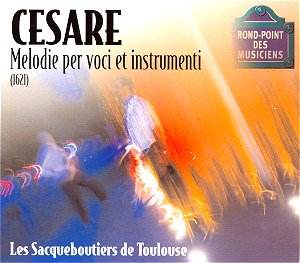Giovanni Martino Cesare
was born in Udine, but worked outside
Italy during the largest part of his
life. Around the time he published his
first collection of music (Magnificat
item Antiphonae Mariales, 1611) he was
a cornettist at the court of the Margrave
of Burgau at Günzburg, near Augsburg.
He became connected to Duke Maximilian
of Bavaria, in whose chapel in Munich
he played in 1612; in 1615 he entered
Maximilian’s service. His ties with
Augsburg never loosened, since the collection
of instrumental canzonas and motets
which is recorded here, is dedicated
to the Fugger family of Augsburg. Several
pieces in the collection have titles
which refer to members of this family,
like ‘La Giorgina’ and ‘La Massimiliana’.
Other pieces are references
to the places where he spent most of
his life: ‘La Augustana’ refers to Augsburg,
‘La Monachina’ to Munich and ‘La Bavara’
to Bavaria.
The canzona ‘La Hieronyma’
is remarkable in that it is the first
piece – as far as we know – which is
specifically written for the trombone.
A special feature of this collection
is that the instrumentation is specified
in detail. The instruments needed to
play these pieces are the cornet – Cesare’s
instrument - the violin, the trombone,
the viola da gamba and the organ as
a continuo instrument.
The motets – or rather
sacred concertos – are set for voices
and instruments, which enhance the expression
of the texts.
Cesare obviously was
held in high regard in Bavaria. His
music was included in important publications
of his time. Unfortunately the interpretation
doesn’t reflect the high reputation
of Cesare’s music.
This is a typical example
of a recording which looks fine: all
singers and instrumentalists are specialists
in the field of early music and have
demonstrated their skills in numerous
recordings. The singing and playing
is stylish, the singers blend well and
the ensemble is playing really well.
But something is missing.
Although the Italian music of the early
17th century belongs to my favourites,
I had trouble listening to this CD in
one session. It is all too one-dimensional.
There is a lack in differentiation between
the pieces, and also between the sections
of some works. The playing is very correct,
and very neat, but mostly without any
fire or excitement. The texts of some
vocal items are rather passionate. In
the ‘Salve Regina’ a line like "ad
te suspiramus, gementes et flentes in
hac lachrimarum valle" needs much
more passion than the singers show here.
And a jubilant piece like ‘Jubilate
Deo’ is far too restrained. Only in
some items the singers demonstrate real
emotion, like the two tenors in ‘Assumpta
est Maria’. They also show real excitement
in the closing lines of ‘Isti sunt duae
olivae’.
And why there is so
little ornamentation even where the
music practically begs for it is beyond
me.
The booklet leaves
much to be desired. There is no indication
of the scoring of the items nor who
is singing or playing which piece.
The lyrics in the booklet
are full of printing errors; there is
hardly one item which is printed correctly.
Since there is an English translation
of the liner notes it is rather strange
that the lyrics are only translated
in French.
The lyrics are not
printed in the same order as they appear
on the CD. That in itself is annoying,
but even more so since some items have
the same title.
This could have been
a very good recording. But I can only
recommend it to those who are interested
in having this whole collection of music
for its own sake. And listeners are
well advised no to play the whole disc
in one session.
The reputation Cesare
obviously enjoyed in his lifetime is
fully justified, but the musicians haven’t
done him real justice.
Johan van Veen
